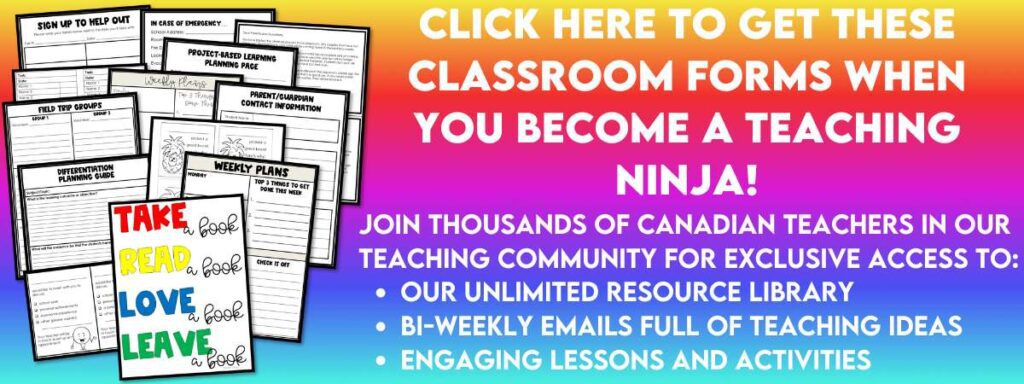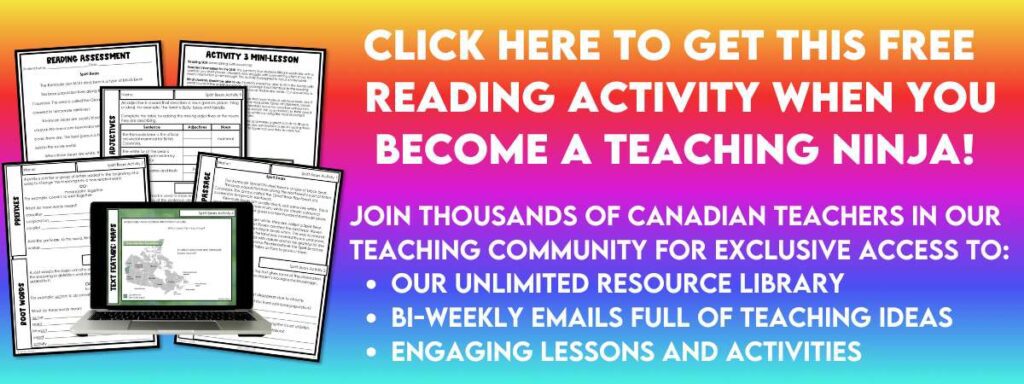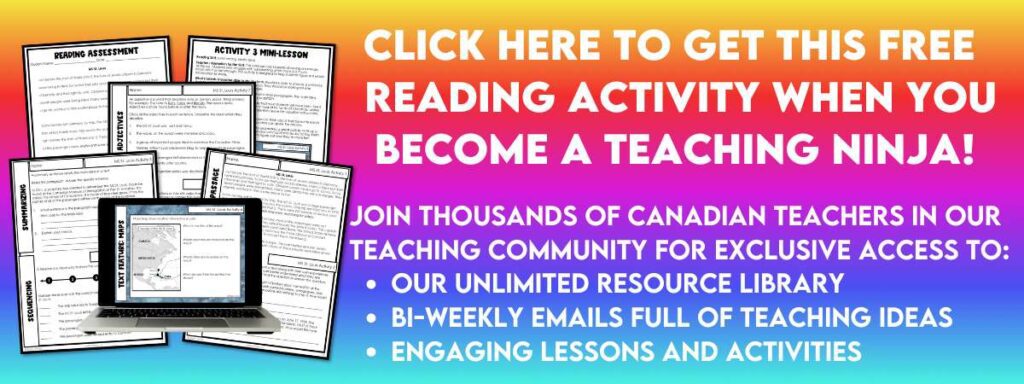
You are a great teacher, but don’t have a classroom library? Of course, you want your students to have a great selection of books for reading throughout the year, but most schools do not pay for classroom libraries. How on Earth are new teachers (and even the more experienced ones) expected to have a quality selection of classroom library books?
What are some ways to stretch your classroom library to get books into the hands of every one of your students?
First of all, we believe that the obligation of buying a classroom library belongs to the school or school board. We don’t think teachers should have to spend their own money to fund their classroom library, but we also understand that because of the giving nature of teachers, you are more likely to buy books for your students than to have them go without. Just be mindful of how much you spend over the years. It can add up FAST! Make sure you carefully label your personal classroom library books so they can easily be separated from the school-owned books.
Buy them
Yes, most teachers have to buy their own classroom library books. Rather than paying full price for new books try garage sales, used books stores, and public library sell-offs. Sometimes retired teachers and teachers leaving the classroom have books they are giving away for selling for cheap. Occasionally you can get a coveted invitation to a warehouse sale through your local public library or Scholastic. And don’t forget about those tiny little used bookstores no one seems to know about where sometimes you can get a lot of books for a fraction of the price. If you’re in the Edmonton, Alberta, Canada area check out Kids Books 4 Less.
Ask for donations
Lots of families have lots of books sitting around at home collecting dust and most parents are happy to get them out of the house. Write a note explaining the types of books you are looking for and where to bring donations. Be sure it’s clear these are donations to the school so no one is surprised when the book isn’t returned to the family.
Talk to your coworkers
Lots of teachers change grades and are left with all their classroom books for the wrong grade. Maybe they have a classroom library for the grade you need and are willing to sell, lend or give to you. Just be wary of receiving old books that your students are not going to want to touch (because they are smelly, dusty or completely out of date).

Trade halfway through
We share our classroom library with another teacher with the same grade. Halfway through the year, we switched all the books in our classroom to her classroom and she gave us all of hers. That way we only need half the books. This can also work with friends who teach the same grade at another school or the grade above or below yours. As a bonus we have our students carry all the books from one room to another and they get excited to see all the new titles as they are carrying them and putting them away on the shelves.
Watch for library discards
Sometimes these books are given away for free. Your school library or even the public library sometimes needs to weed out extra copies. Sometimes these are BRAND NEW!
It is so nice to come into our classroom every single day and see our very own little library. ~Taylor R. Age 10
Ask for money
If the books are going to remain with the school instead of your personal classroom library, ask your administration for money. It might work. If there is no money perhaps a fundraiser might work. Maybe your parent council has money for books? There is no harm in asking.
Write grants or apply for crowdsourcing
Sites like donorschoose.org While school boards in Canada have stricter rules about how teachers raise money for their classrooms, it might be worth looking into grants from private businesses like Chapters/Indigo and the Love of Reading Foundation.
Enter contests
Scholastic often has contests for book prizes. It takes time, but it can help build up the classroom library.
Sign up for Scholastic Book Clubs
When parents buy books, you earn rewards that can be used to purchase new books. Contact Scholastic in your country to set up an account. Scholastic Canada You can even host a book fair. Yes, they are a lot of work, but maybe your parent council can help with spreading the work out over a couple of days. Schools can earn up to a few thousand dollars depending on the size/economic situation of your school population.

Use your school library
We often sign out 20-30 books and keep them in the room for about a month. It’s easy to switch out the books and they’re free.
I don’t know how you found the time to read all of these books. ~Harry G. Age 9
Look for online options
Epic! is an online lending library available to teachers for free. You can create accounts for your students where they can access so many great books!
Many public libraries offer digital versions of books (or audiobooks). Check with your school or community librarian about how to get started.
Look for local companies
Some local companies are willing to partner with your school to get books in the hands of students. Approach family-owned businesses to see if they’d like to sponsor your school to buy some books.
Look for non-profit organizations
First Book Canada is an example of an organization that works to get books for students. A similar organization in the United States is Kids Need to Read.
Join book reviewer organizations
If you preview books, read them and write reviews you can often get a free copy of the book. Yes, it takes time to read these and write the reviews, but if you’re already an avid reader this might be a way to get your hands on new books.
Create a wish-list
On your Amazon account, you can create a wish list. You can share your wish list with the families in your school to ask them to purchase books for the school instead of gifts for teachers.
When I grow up and I’m a teacher, I’m going to cover all the walls with books. I can’t wait! ~Alma F. Age 10

Fund Raise
Yup, have a good ol’ bake sale or popcorn sale where the proceeds go to purchasing books for your classroom. Be upfront that the sale is to buy books for the school and check with your district’s policy on fundraising of this kind.
Talk to your community librarian
Most public libraries are affiliated with schools and have a librarian whose job is to connect with schools. These librarians can share information about reading programs, get your students signed up with library cards and might know of some great ways to get your hands on more books.
E-books and Audiobooks are your friend
You would be shocked to learn how many programs have been purchased by your school district. If your school already owns the license, there is probably a few quick steps to get your classroom touching (virtually of course) those books. A program like Reading A-Z (Raz-Kids) might be licensed by your school.
Read aloud
Sometimes you don’t have enough books so reading to your students can be one way to spread the love of reading.
Explore
If you search online you can find all kinds of interesting ways to find online audiobooks. Many of these are for younger students, but for upper elementary books try Funbrain. It has featured books that students can read online. For best results access this from a laptop, desktop or Chromebook. It’s a little glitchy for tablets.
Trade books
Students (with permission from their parents) can bring books to trade at school, or if you have friends and family members whose children have outgrown their personal collection, you can start to have a shelf where students can trade out books so they can read new ones. Sign up for our email list, where you can get unlimited access to our free Resource Library. Our book trade posters are available there at any time. We also use these posters in our staff room. Staff members bring in books they’ve finished reading and take home new books they haven’t read. It works for both professional and personal reading.

I could read a book a day for the whole school year and still not finish them all. I don’t even know where to start. ~Jae G Age 10
Don’t be discouraged if you can’t get your hands on a lot of books right away. It takes time to build up a quality collection.
Your classroom library reflects your priority in teaching reading.
When you don’t have books available for your students, you are giving them the message that reading isn’t important. You’re a teacher. You know that as students move further up the grade levels, they shift from learning to read into reading to learn. If they’ve missed reading skills along the way, they are already identifying as ‘not a reader.’ You can shift this thinking by offering multiple opportunities every single day.
Related: Strategies for Reluctant Readers
Ok, I’ve tried all of this and I still don’t have enough books for my students.

Don’t sweat it. You will get there. If it’s a case of ‘can’t afford’ you still have lots of options.
Visit your school library
Take your kids to the library as often as possible for now. If your school has a schedule, try to find a time that works when your class can spend a bit of extra time in the library (even if it’s just to do some work with a change of scenery).
Host a read aloud
Read out loud to your students (because even older students enjoy listening to their teacher read them a book). Maybe take it a step further by inviting local celebrities to read to your students (or your mom). Parents, grandparents, older students or principals can also make great guest readers.
Don’t forget about that public library
Ask your public library to come help students sign up for library cards to your local public library. If your school is nearby maybe you can visit the library occasionally. The more books available to your students, the more they will have the opportunity to read. Show them reading is a priority in your classroom by creating opportunities to share their love of reading.
Look for alternatives to traditional books
Can you read magazines? What about online blog posts? If you have access to a computer in your classroom you have lots of options for reading material. Don’t forget about those old dusty textbooks. Sometimes a few pages on a topic that interests a student might be just enough for a reading session.
Pair read
Match up two students who will sit together to read a book. They can alternate between each other to read out loud, read silently side by side (waiting for each other at the end of the page) or read in unison together. This also creates a built-in partner to discuss the book.
Share Your favourites
You probably have a personal copy of your favourite book. Share it with a trusted student (well, maybe not if it’s a signed first edition) or buy one extra copy to read to your class. If you tell people it’s your favourite you’re likely to get a copy as a gift along the way.
Collect Recommendations. There is a never-ending supply of new books, but how do you know which ones are good? Ask your students to recommend books to you. Use our Book Recommendations sticky notes. We can send you a set, or you can find them inside our Resource Library.
Include parents in your plan
Explain to parents your book shortage and how they can help by reading at home every chance they get. Encourage them to get to the public library and then share what they have been reading at home. Ask parents to talk with their children regularly about why reading is so important to learning.
Never stop advocating
Teachers should not have to spend their own money to buy books, but we will admit to spending thousands of dollars over the years to buy books so that our students will have them to read. We continually talk to the powers that be (principal, superintendent, government officials in charge of education, school boards) that more needs to be done to ensure the resources students need are included in classrooms.
Think Outside the Book
We found it very difficult to get enough copies of digital books to our students once the pandemic started. Our solution was to write our own reading passages because we didn’t have textbooks. You can learn more about that in our post Add Great Content to Your Literacy Lessons. You can try one of our free reading passages that are part of our weekly reading comprehension series.
This passage is designed for Grade 4 and is all about Spirit Bears. It can be found in our Resource Library or we can send it directly to your inbox when you join our email list.
This set is about the MS St. Louis. It was a ship full of Jewish passengers who tried to escape Germany prior to World War 2. Canada (and other countries) refused to let it land, and many of the passengers were forced to return home, where they were killed. This set is designed for Grade 5 and can be found in our Resource Library. If you’re not a ninja yet, we can send it to you when you join our email list.
Do you have any tips for getting more books into the hands of your students? Leave us a comment below.








